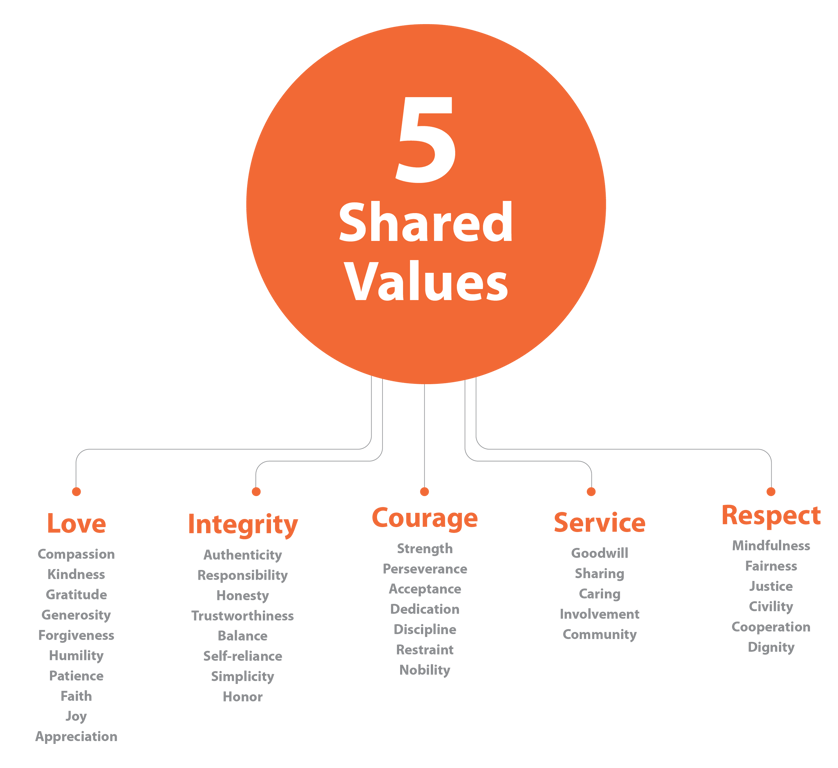The Symbiotic Age Has Begun—What If Love Was the Blueprint for Society?
FAQ Series: What Is Birthing the Symbiotic Age and Why Does It Matter?
Frequently Asked Questions (FAQ) Series:
What Is Birthing the Symbiotic Age and Why Does It Matter?
We all feel that deep tension between how we know we are meant to live and how the world trains us to survive.
I wrote Birthing the Symbiotic Age to help name that tension, trace its roots, and offer a practical path forward. We are living through the unraveling of an old story—one defined by separation, domination, and disconnection from the sacred. But beneath the noise, a new way of life quietly takes root.
I call it Symbiotic Culture—a way of living that realigns our personal lives, communities, and systems with the relational wisdom woven into creation. This post is the first in a series of FAQs introducing the vision behind the book: a sacred Culture of Connection rooted in Love, spiritual coherence, and community. Whether you’re new to these ideas or have walked this path for years, I invite you to explore what this cultural transformation might mean for you and all of us.
FAQ POST 1 — WHY AND WHAT
What is this book about, and why does it matter?
The first FAQ post addresses “what” and “why.”
We stand at a civilizational threshold.
This book—and the culture it seeks to catalyze—offers not a blueprint for power, but a pattern of sacred relationship. Here’s what it’s about, and why it matters now.
I. PERSONAL MOTIVATION: Why this book, and why now?
1. WHY DID YOU WRITE BIRTHING THE SYMBIOTIC AGE?
Because I believe we are being called to remember how we are meant to live, rooted in connection, care, and sacred purpose. This book was born from the deep tension I’ve witnessed and felt between what we know in our hearts and the Culture of Separation that conditions us to live otherwise. Over the past 40 years, I’ve walked a path shaped by what I call the Ancient Blueprint—a living design revealed most clearly to me through the teachings of Jesus, and reflected in the village-based movements of Gandhi and Dr. A.T. Ariyaratne, the Czech Parallel Polis, and my own work building Symbiotic Culture in Western cities.
That’s why, rather than fighting or dismantling existing structures, this book focuses on weaving together what already works—currently isolated “islands of coherence”—and culminates in a practical action guide to help activate a new global commonwealth of 50,000 villages, towns, and cities worldwide. It’s not just a vision—it’s an invitation to reweave society around the organizing principle of Divine Love.
2. WHAT IS THE CORE MESSAGE OF THIS BOOK?
That Divine Love is not just a feeling or belief—it is the very structure of reality. We are not isolated individuals but participants in a sacred, interconnected web of life. The crises we face—personal, cultural, and ecological—all stem from forgetting this truth. Birthing the Symbiotic Age calls us to remember who we truly are and to realign our lives and communities with that deeper order. This is the message embodied in Jesus Christ's life and teachings—and it extends beyond any one tradition. The path forward is not domination or escape, but communion—through Love, Virtue, and the shared work of healing and reweaving the world from the inside out.
II. THE BIG PICTURE: What is this moment in history asking of us?
3. WHAT IS THE SYMBIOTIC AGE, AND WHY IS IT IMPORTANT NOW?
The Symbiotic Age is an emerging era based on what I call a Relational Worldview—a way of seeing life that emphasizes our deep interconnection with each other, the Earth, and the Divine. It calls us to realign human culture with the sacred order of creation through Divine Love, which is rooted in the Christian understanding of Love revealed in Jesus.
We stand at a crossroads. The old systems—marked by domination and fragmentation—are collapsing. In their place, a new culture is emerging—one that honors moral formation, spiritual awakening, ecological balance, and interdependence. This is more than reform; it’s an evolutionary leap toward a way of living grounded in shared purpose and sacred trust. Now is the time, because the pain of separation has ripened into readiness. The Symbiotic Age is not utopia—it’s a practical, spiritual invitation to grow up together.
4. WHAT IS THE FOUNDATION OF SYMBIOTIC CULTURE?
At a time when worldviews seem irreconcilably divided, Symbiotic Culture is grounded in something that transcends ideology: a relational worldview capable of bridging difference and reconnecting what has been torn apart. A relational worldview sees life as deeply connected—not just in theory, but in the very structure of reality. For me, this understanding began with a spiritual awakening at age twelve—an overwhelming sense of being held by a Presence that was loving, alive, and everywhere. Years later, I encountered that same Presence moving through the natural world. In the forest, I began to see the living web of creation—not as metaphor, but as a sacred design where everything supports everything else.
This vision was later echoed in Jesus’ Sermon on the Mount and the early Christian communities, as well as in Gandhi’s village movements, Sri Lanka’s Sarvodaya Shramadana, and the Parallel Polis in Czechoslovakia. I saw this pattern of mutual flourishing—what science now calls symbiosis—not only as a biological reality, but a spiritual one. This is the foundation of Symbiotic Culture: an ancient, relational pattern pointing toward the next step in human evolution—a world where all can thrive.
5. WHAT IS MEANT BY “CULTURE OF SEPARATION,” AND HOW DID IT COME TO DOMINATE?
The Culture of Separation is a worldview rooted in disconnection from each other, the natural world, and the Transcendent. It arose through millennia of domination systems prioritizing control, competition, and the illusion of the separate self. These systems fragment our institutions, relationships, and even our inner lives, cutting us off from natural order and sacred purpose. In contrast to the relational message at the heart of the Gospel, Western society has enshrined materialism and individualism, creating deep social division. However, such systems inevitably break down because they violate the fundamental structure of reality: that everything is interconnected through Divine Love.
III. CORE CONCEPTS: What is this book proposing?
6. WHAT IS THE “ANCIENT BLUEPRINT” AT THE BOOK'S HEART?
The Ancient Blueprint is a sacred, living pattern woven into creation—a relational design revealed through the life and teachings of Jesus, Indigenous wisdom, natural systems, and the heart of many faiths. It offers not just personal guidance but a framework for building healthy, interconnected communities rooted in Love, mutual care, and Divine alignment. Though largely forgotten by modern, disconnected culture, this deeper order still lives in our spiritual memory. The Blueprint is profoundly relevant today, providing a path not to invent something new but to remember what we have forgotten. This book helps us re-embody that sacred pattern as we heal fragmentation and co-create a more whole society.
7. WHAT IS SYMBIOTIC CULTURE, AND HOW IS IT DIFFERENT FROM TRADITIONAL COMMUNITY BUILDING?
Symbiotic Culture is more than working together—it’s living from a relational ethic where mutual benefit becomes the norm. It’s a Culture of Connection where Love, trust, and shared purpose guide decisions across every level—from personal life to global systems. While community building often focuses on projects or partnerships, Symbiotic Culture transforms the deeper “how” and “why” behind those efforts. It’s not just about shared goals, but a sacred logic: healing the divide between self and other, human and nature, spirit and society. It reorients daily life around the intention to nourish others as we ourselves are nourished—intentionally, generatively, and spiritually.
8. WHAT ARE THE TWELVE COMMON NEEDS YOU MENTION, AND WHY DO THEY MATTER?
The twelve common needs—Food, Economy, Energy, Water, Neighborhoods, Education, Governance, Faith and Meaning, Health and Healing, Environment, Arts and Culture, Youth and Elders, Media and Storytelling, and Justice and Safety—represent what every community must nurture to flourish. They’re universal, practical, and unifying. By organizing collaboration around these needs, Symbiotic Networks create trust and shared purpose across divides. These needs become portals for healing fragmentation, building relational coherence, and reweaving the social fabric. When we meet each other here, beyond narrow ideologies or polarized systems, we begin to “re-platform” Love in the public square. Focusing on these twelve areas grounds spiritual awakening in embodied, place-based transformation.
9. WHAT IS THE “PARALLEL POLIS” AND HOW DOES IT APPLY TODAY?
The “Parallel Polis,” first developed under Communist rule in Czechoslovakia, was a way for citizens to create a free and moral society alongside a corrupt system, without confrontation or withdrawal. It focused on building independent networks of truth, trust, and human dignity amid authoritarianism. Today, we face a different kind of disintegration—spiritual, ecological, and civic. The Parallel Polis offers a model for cultivating coherence in fragmented times. It shows that cultural transformation can begin quietly, relationally, and locally—by building new structures of belonging that reflect our deepest values rather than dominant ideologies.
IV. SPIRITUAL FOUNDATION: What’s the deeper metaphysical and moral grounding?
10. WHY DO YOU CENTER YOUR VISION ON LOVE, VIRTUE, AND SPIRITUAL COHERENCE?
I believe true transformation must be both inward and outward, personal and collective. Divine Love opens us to a reality that dissolves the illusion of separation, but without virtue, that awakening can remain fleeting or ungrounded. Virtues are the bridge: they embody sacred truths in daily life and form the moral architecture of a just and sustainable culture. Yet modern society often resists the sacred as an organizing force, clinging instead to control, materialism, and ego. As Jesus taught, the way of Love—embodied through virtue and sustained by spiritual coherence—is the seed of the Kingdom, hidden in plain sight, waiting to regenerate both soul and society.
11. WHY DO YOU USE THE TERM “TRANSCENDENT” AND “DIVINE LOVE” RATHER THE JUST “GOD”?
I use “Transcendent” and “Divine Love” to point beyond limited or culturally loaded images of “God.” These terms open space for a broader, deeper understanding that honors the sacred across many faiths while remaining faithful to the Christian revelation of Love embodied in Jesus. “Divine Love” emphasizes God’s nature as relational, generative, and active in the world, not just a distant ruler, but the living source that binds all creation. It bridges spiritual traditions and invites people into communion, beyond dogma. This language fosters inclusion while still pointing to the sacred mystery that transforms everything.
V. PATH FORWARD: How is this approach different—and how does real change begin?
12. WHY IS MORAL FORMATION FOUNDATIONAL TO CREATING NEW SYSTEMS, STRUCTURES, AND INSTITUTIONS?
Because without Love at the center, even new systems become self-serving, transactional, and prone to domination. History is full of failed reform efforts because they overlooked the inner transformation needed to sustain justice and care. Moral formation cultivates the virtues—like humility, courage, and compassion—that shape people capable of stewarding new structures with integrity. When moral clarity precedes institutional design, we create cultures of coherence, not control. Systems don’t save us—people do, when rooted in the sacred. Institutions must emerge from, and remain accountable to, transformed individuals living in alignment with Divine Love and the common good.
13. WHY IS THE PATH FORWARD NOT FOUND IN POLITICS, RELIGION, OR ECONOMICS ALONE?
The crisis we face is not just political, religious, or economic—it is spiritual and cultural. Beneath our failing systems lies a fragmented cultural matrix that touches every domain: media, education, military, governance, religion, and markets. These systems reflect a more profound disconnection from the sacred order of life. Fundamental transformation must address the root—a Culture of Separation—by reweaving the fabric of meaning, relationship, and moral purpose. Only a cultural shift grounded in Divine Love and shared Virtue can bring coherence across all sectors and birth lasting change.
14. WHY DO YOU EMPHASIZE SMALL-SCALE, REGIONAL, RELATIONAL TRANSFORMATION OVER LARGE-SCALE NATIONAL AND GLOBAL CHANGE?
Because real transformation grows from the ground up. Systems rooted in the Culture of Separation often impose change from above, reinforcing disconnection and dependence. But healthy societies emerge organically, like ecosystems, through relationships of trust, care, and shared purpose. Local and bioregional efforts are where culture becomes embodied, where people can see and feel change. This mirrors the early Christian communities, the principle of subsidiarity in Catholic Social Teaching, and decentralized movements like those of Gandhi, Dr. Ariyaratne, and the Czech Parallel Polis. The Symbiotic Age grows not through control, but through living networks rooted in love, virtue, and community.
15. WHAT DIFFERENTIATES THIS BOOK FROM OTHER SPIRITUAL, SELF-HELP, OR SOCIAL CHANGE TEXTS?
This book isn’t about self-optimization or personal success—it’s about sacred transformation. It challenges the self-help gospel of individualism and instead invites a journey from ego to essence, from domination to symbiosis, from isolation to communion. While I speak of the “Authentic Self,” it’s not about achieving a better version of yourself—it’s about rediscovering your role in a relational cosmos shaped by Divine Love. Birthing the Symbiotic Age is both spiritual and social: it unites inner transformation with outer cultural renewal, calling us into community, virtue, and sacred responsibility as the foundation of a healed and coherent world.
Stay tuned for the next FAQ instalment. Please feel free to reply to this message or make comments.
In the meantime, please check out these relevant posts:
The first is about the origins of the Parallel Polis (society). The second and third posts are the Preface and the Introduction from my upcoming book, Birthing the Symbiotic Age.
Living in Truth: Building a Parallel Polis Within a Spiritually Hostile Regime, Chapter 12, Part 5
Welcome to the Birthing the Symbiotic Age Book!
Living Between Worlds: with Audio
Dear readers, I am very excited to give you a sneak peek of the preface from my upcoming book, Birthing the Symbiotic Age. For many of you, it has been a journey of more than a year, as I have been sharing the first three of the four sections of the book right here on Substack.
The Turning Point We’ve Been Waiting For
Dear readers, I am happy to share a sneak peek of the Introduction from my upcoming book, Birthing the Symbiotic Age. I have been releasing the first three quarters of the book freely here on Substack, starting in January 2024!










“When moral clarity precedes institutional design, we create cultures of coherence, not control. Systems don’t save us—people do, when rooted in the sacred. Institutions must emerge from, and remain accountable to, transformed individuals living in alignment with Divine Love and the common good.” Richard Flyer
Aho!!